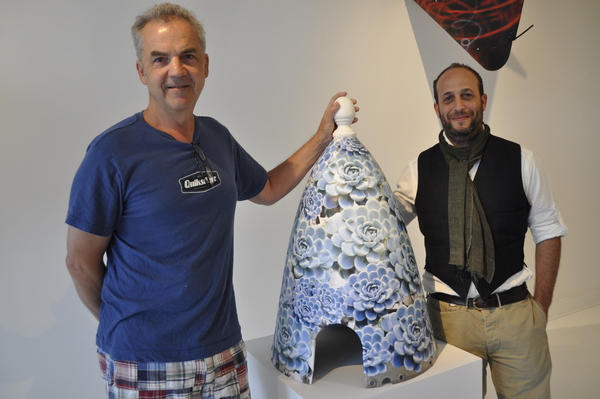
Last spring, culture writer Carlo McCormick had an unexpected conversation with East Hampton gallery owner, and friend, Eric Firestone.
Mr. Firestone, having longtime operated a gallery in Arizona, was familiar with and fascinated by the state’s “bone yards,” where United States Air Force planes go to die, and realized he had an idea, according to Mr. McCormick.
“Eric was like, ‘Carlo, there’s some really cool stuff out here. You should come out and look at them and we can do a show together,’” Mr. McCormick recalled, taking a sip of his iced coffee outside The Golden Pear Cafe in East Hampton. “And I was like, ‘Eric, I don’t want to do a show with a bunch of junk.’”
But with an unrelenting push from Mr. Firestone, Mr. McCormick said he soon found himself on a plane to Arizona and then in an airplane graveyard. He was mesmerized by what he saw.
“It was just scrap metal everywhere,” he said. “I could see people had already picked through stuff, but no one had any interest in the noses, the actual front. It’s a weird, irrational object, but I thought, ‘Hmm, well it would be fun to do a tribute to nose art.’”
Nose art is decorative painting on the fronts and sides of airplanes that dates back to World War I. To give it a contemporary twist, the two men invited about two dozen artists to transform the relics—ranging from 3 to 6 feet tall—into sculpture art, which was unveiled during the opening of “Nose Job” last Friday at Eric Firestone Gallery in East Hampton.
“In a weird way, it was like plastic surgery,” said artist Peter Dayton, standing next to his nose cone, “Stairway to Heaven.” “So I was the surgeon. I had to be careful not to over-tuck it or stretch it too much.”
Starting out, Mr. Dayton knew he wanted a spot in the group show, but admittedly showed a little trepidation, he recalled. His first two design attempts—first covering the nose in skulls, and then daffodils—were all wrong, he said, and he finally settled on a blue flower motif.
“Its history did play into it in that I didn’t want to reference war, destruction and violence, the American industrial killing machine,” he said. “I wanted to take it the other way.”
Mr. Dayton was one of the artists on Mr. McCormick’s “wish list,” the curator said. When Mr. Firestone purchased the nose cones, none of the artists had even been approached about the project yet.
“I thought maybe if two or three of them said yes, then I can at least make Eric’s nut for the month, so he wouldn’t be totally screwed,” Mr. McCormick said. “But they all said yes. I was like, ‘I don’t want to strong-arm you into this show,’ and they were all like, ‘No, I want a nose.’”
Unpacking the noses several days before the opening was like Christmas, Mr. McCormick recalled. He had no idea what he was going to get. After all, he hadn’t given the artists any guidelines or rules.
“I trust artists to be alchemists, that they can kind of turn shit into gold no matter what you give them,” Mr. McCormick said. “I think everyone who comes in will have different responses. The show’s open-ended, and so are some of the works.”
Artists Carlton DeWoody and Sebastian Errazuriz, who are together known as “Juan James,” said they decided from the get-go to clearly acknowledge the nose cone’s past, but wanted to leave their creation up to interpretation.
Fitting their two assigned nose cones together, the finished product resembles a bomb with the words “Never Forget” in script along its side and a Star of David on the top, a nod to the pair’s second project together, “Blue, White and Blue”—a hybrid of the American and Israeli flags that is hanging on display over the noses.
“So we thought, ‘Why don’t we make a nuclear bomb that kind of represents the nuclear power between these two?” Mr. Errazuriz explained.
“Or at least suggests it,” Mr. DeWoody added. “It sort of could be a space pod. It could be a satellite. It could be a bomb. We wanted to leave it up in the air. We’re stoking the fire but not taking a position either way.”
Both artists said they were very conscious that they were essentially making a piece of art from recycled material, or “junk,” as Mr. DeWoody called it.
“Make it polished but leave space for people to make up their own story,” he said.
Some of the artists not only gave the nose cones a skin but turned them into entirely new objects, Mr. McCormick pointed out. Shepard Fairey made his nose into a giant megaphone with the words “Amplify Your Voice” across its side, whereas Raymond Pettibon wrote a very intense text on his piece about his father, who served as a pilot in the Air Force.
“I think some are pretty personal and some are very poetic,” Mr. McCormick said. “I think that we all have our own idea for what it means to be in an airplane or the history of military air power. We’ve long had the dream of flight and we can think of it mythically like Icarus, or like art, like da Vinci’s drawings, imagining it centuries before we’d even get there. Even if the artists’ work isn’t all about that, it’s part of what compelled them.”
Eric Firestone Gallery’s summer group show “Nose Job” will run through Sunday, August 21. For more information, call 604-2386 or visit ericfirestonegallery.com.